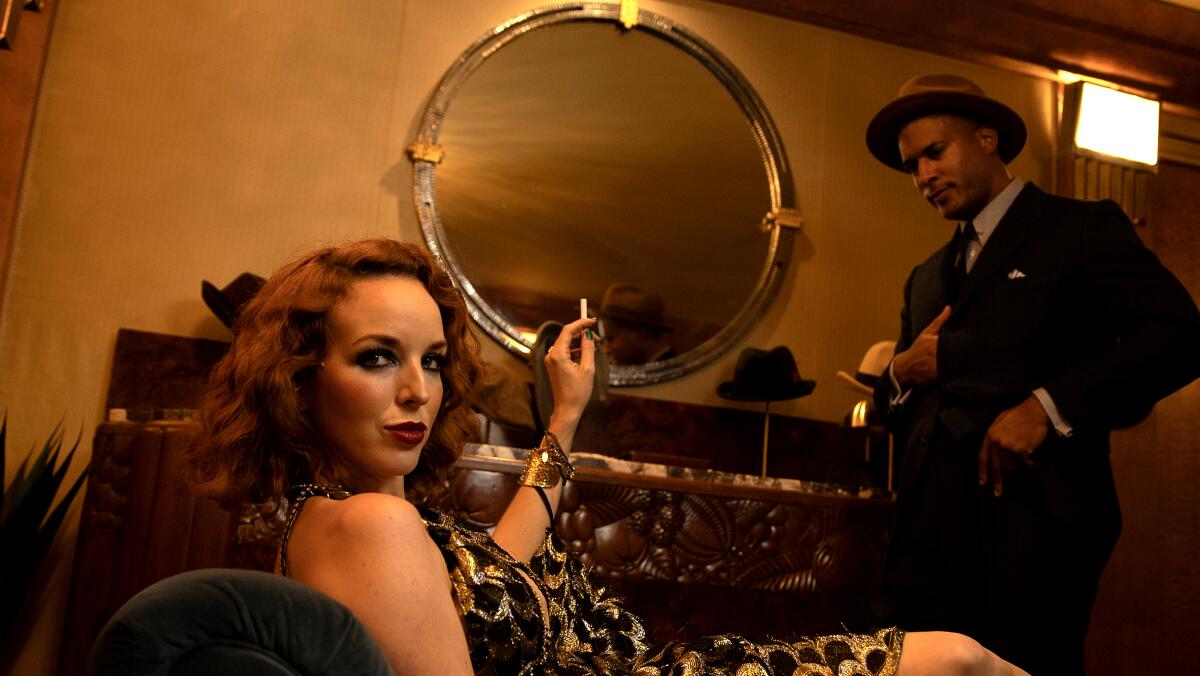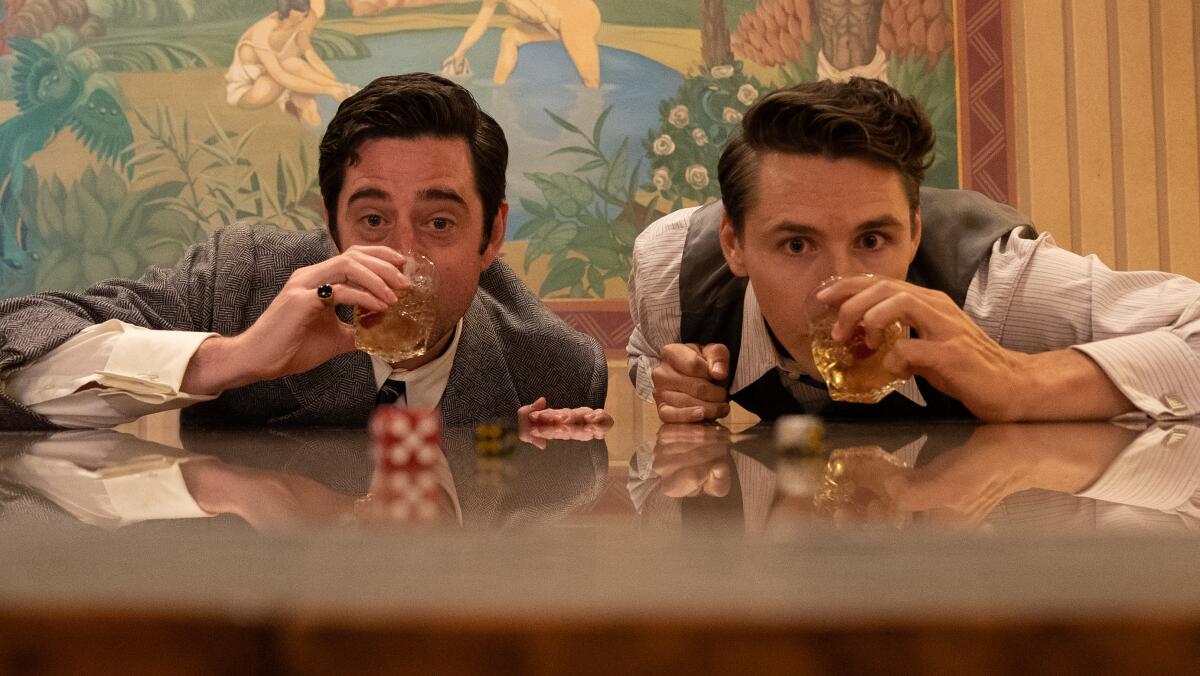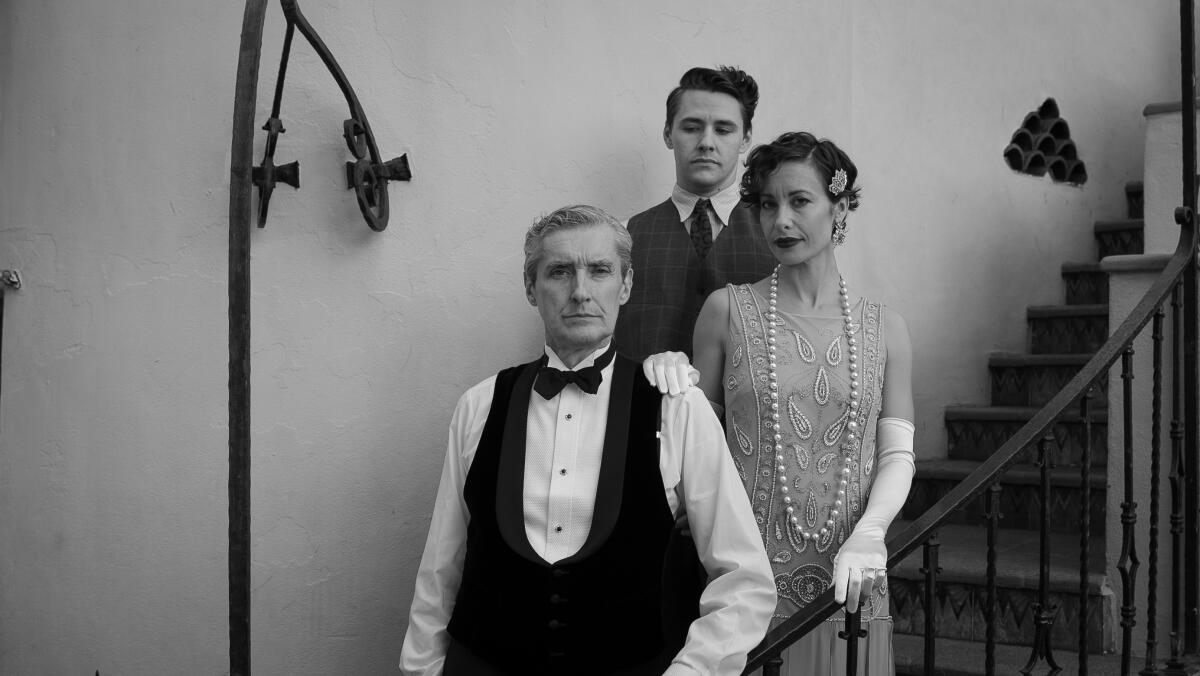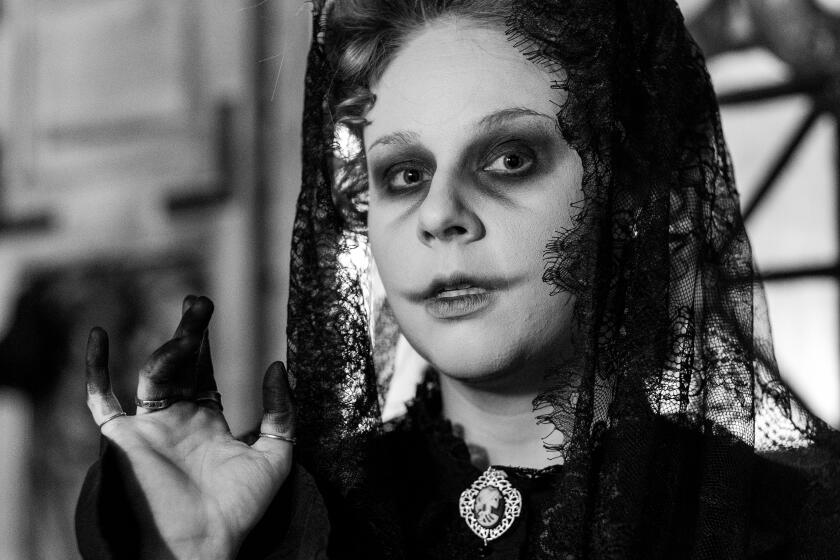Inside L.A.’s famous Art Deco penthouse, this show has you choose your own dark adventure

- Share via
In a story with outrageous, less-than-savory personalities, one character stands apart: the stage.
Or, in this case, the 13th-story penthouse of the Oviatt, which is the setting for a new immersive theater production running this month in downtown. “Castle in the Sky” aims to tell a slice of a mostly forgotten Los Angeles tale: the high-society life of James Oviatt, the once renowned clothier of the silent film era who had a long, slow fall from grace.
The name of the show stems from the nickname for the Art Deco palace, which sits atop an Olive Street building in Oviatt’s name. The penthouse is a collection of intimate rooms, each ornate and filled with personal, hand-crafted details (some of them eccentric, such as a tiny space designed to mimic a private rail car).
“Castle in the Sky” is designed so that guests follow certain actors from room to room during an Oviatt-hosted party. Each scene is short, at about five minutes, and participants choose their own adventure throughout; they might, say, spend the evening trailing actors playing Oviatt and his family or tail other performers playing invited guests.
Outfitted in French marble, zebra-skinned bar stools and exquisitely etched windows that block the view of downtown — a narcissistic move that seems to argue that what’s inside matters more than the world beyond — Oviatt’s penthouse is dedicated to the preservation of consumption. This paper, in 1930, described the residence as “architecturally graceful, luxurious in appointments, sumptuous and artistic adornment.” The ground floor of the building, now home to the Cicada Club, once housed Oviatt’s prestigious clothing store, Alexander & Oviatt.
“Castle in the Sky” probes what kind of temperament it takes to create such a space, one equally dedicated to socializing and a flaunting of wealth with fragile accouterments — those etched windows came courtesy, for instance, of famed artist Rene Lalique. The story isn’t pretty, but it’s also one that has to walk a delicate line. Oviatt in his later years became known for extreme right-wing views, so much so that he once described to this paper the racist and antisemitic Christian Defense League as “a great organization.”
The show explores the tension in a certain kind of excess. There is a lonely desire to belong, and it is contrasted with a warped, offensive idea of the immaculate.

Stories of Oviatt sometimes speak of his perfectionism with nostalgia rather than the harassment that it was. According to myth, he made the trip from his penthouse to the store early each morning, and theatrically dragged his white gloved hands over the shop’s display cases on the prowl for dust. Unsaid but presumed is the disappointment that followed.
“It’s an eat-the-rich story,” says Tracy Phillips, one of the three principals with Under the Rose productions, of which the self-funded “Castle in the Sky” is its first show.
“I think that’s the only way to handle somebody like that,” adds Phillips, a longtime dance choreographer.
“Castle in the Sky” is set during the Prohibition era, when Oviatt was at the height of his power and social prominence.
“The present doesn’t look back fondly on a lot of people in history, particularly him, if you know anything about his unsavory characteristics, to say the least. We don’t go there in the show, but we make sure that we destroy him. This is not a good guy,” Phillips says.
The Ministry of Peculiarities is one of the most intricate and detailed escape rooms in the Los Angeles area. Only don’t call it an escape room.
In addition to Phillips, Under the Rose is run by Denna Thomsen and Kristin Campbell-Taylor, all veterans of various aspects of the L.A. dance community. “Castle in the Sky” came together in about six months, the three say, although they had been tinkering with an immersive concept inspired by the first Academy Awards in 1929 at the Hollywood Roosevelt before discovering the Oviatt story. When looking for venues to house a production, they stumbled upon the Oviatt building and its penthouse and learned some of his history. They immediately changed course. “We were in the space, and it was so beautiful and instantly transported you to a place,” says Campbell-Taylor.
Campbell-Taylor, a producer whose credits include “So You Think You Can Dance” and “The Masked Singer,” says the team was inspired by shows such as “Sleep No More,” a long-running New York production that tasks guests to piece together the narrative by following various scenes throughout the McKittrick Hotel. “Castle in the Sky” participants are invited to stick around after the production for a post-show reception with a bar and a live band; that’s also a good time to mingle with strangers and discuss which scenes each of you missed.

“We worked really hard to weave together and craft narrative and emotion so you can have an understanding, even if you don’t know what happened,” Campbell-Taylor says. “Our show is a deconstructed narrative, but it does have a beginning, middle and end for each character, and a beginning, middle and end for the show itself.”
In my time with the show on its opening weekend — “Castle in the Sky” runs trough Nov. 30 — I opted to get a glimpse into each character’s storyline rather than sticking with one performer for the evening. I saw the isolation felt by Oviatt’s wife, Mary (Nicole Pacent), the misguided attention sought by his son, James Jr. (Connor McRaith), and a performative marriage from Hollywood actors going up in flames.
The Oviatt I witnessed, as performed by Circus-Szalewski was controlling, voyeuristic and desperate, and it helped to have read up a bit on the real Oviatt’s history before seeing “Castle in the Sky.” To know, for instance, that he proposed to his wife, a former shop girl half his age, after seeing her at work in his store. Oviatt’s name appeared regularly in this newspaper throughout the ’20s and ’30s. His yearly trips to Europe for fashion inspiration were the stuff of gossip-making headlines.
“Thirsty Suitors” is a game about the emotional mess caused by relationships — and how we can heal from it.
“James Oviatt was very transactional in all of his relationships with everyone around him,” Campbell-Taylor says. “Both sides of those transactions was something we explored a lot.”
“Castle in the Sky” can be lightly interactive. For the bulk of the 21 and over show, we are simply an audience, watching in one scene a bedroom seduction and the results of overindulging at a party in another. (It’s said that Oviatt throughout Prohibition had a near endless supply of alcohol, turning his parties into some of the most in-demand places in the city). But there are times we may be spoken to, or find ourselves engaging in a game of Rock Paper Scissors with other attendees.
Other scenes, however, are purely interpretive, pulling on the experimental dance choreography expertise of Phillips and Thomsen. One features a character giving himself a shave, the daily task treated as if it’s a delicate dance atop a music box.
Don’t, in other words, expect any big Charleston-inspired dance numbers. “That’s something we’ve all seen before,” Phillips says. “It was a challenge to stay within the era, but these were full people. They didn’t only do the Charleston. That’s just one little thing that has lingered. They had full lives, and we wanted to express that through dance and performance without falling into a novelty.”
The hope is that “Castle in the Sky” won’t feel solely like a period piece, despite the costumes and aesthetics of the penthouse. After all, its themes, centered on the emptiness of power — and the vapidity of those who seek to be close to it — are timeless, especially in this city.
“We put you in the present, even though we’re telling a story about the past,” Phillips says.
'Castle in the Sky'
More to Read
Sign up for The Wild
We’ll help you find the best places to hike, bike and run, as well as the perfect silent spots for meditation and yoga.
You may occasionally receive promotional content from the Los Angeles Times.









